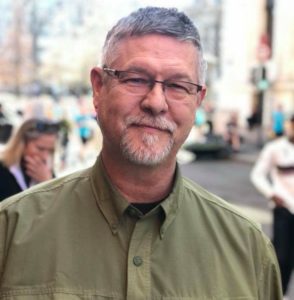I remember first meeting Jim Stark in the small, rehabilitation office tucked away in the basement of Allegan General Hospital. Jim was passionately instructing a patient on body mechanics and my thought was “Wow, this man is a teacher!”
Jim has been passionately learning, teaching and treating patients for the past 26 years. His focus for the last 10 years has been helping patients who suffer from chronic pain.
Jim’s journey into physical therapy began when an active lifestyle found him working in a bicycle shop after an injury that led him to receive physical therapy. He then managed a health club where a physical therapist convinced him to pursue physical therapy. After a year and half of physical therapy prerequisites, Jim started physical therapy graduate school at the age of 35.
I asked him what drove his interest in chronic pain. Jim smiled and responded, “You are not dealing only with pain, you are dealing with people who are in pain!” Jim explained that until Melzak and Wall’s work in 1965 (which they revised a few years later) science’s understanding of pain had not changed from the time of René Descartes in the Renaissance. Descartes theorized that the body was similar to a machine and pain was a disturbance passed down along nerve fibers until the disturbance reached the brain.
The challenge is how to explain pain that persists past 2-3 months. The tissue has healed but what is causing the persistent pain?
Jim referenced the book, Explain Pain, by Lorimer Moseley and David Butler. Moseley and Butler explain pain is a protection mechanism. Chronic pain, therefore, is the protection system stuck in a hypersensitive state. Moseley and Butler state that chronic pain is a neural immune system response. The injured tissue is stuck in a hypersensitive state so it interprets any movement or input as pain.
My head was beginning to spin so I interjected. Where do you start in treating a patient who has experienced chronic pain?

Second, we need to validate the patient’s story. We need to be able to communicate that we believe their story. I always communicate that I believe the patient and I believe his or her pain is real. We don’t have to agree with how they interpret or explain the pain, however, it is essential we communicate that we believe them.
Third, you need to ask permission to start speaking into their problem. Jim suggests asking your patient if they would you like to learn more about chronic pain. If you don’t ask permission to assist them they may not buy into your suggestions for treatment. If the patient sees this as something they agree to, they will be more likely to participate. This approach sounds easy but is challenging. Our current hierarchical clinical model hinders this discovery.
Clinicians are taught the skills and knowledge to provide to their patients. Patients are taught that the medicine, either through a pill, surgery, or exercise, can “fix” them. We have all the answers and hold the key to solving or fixing the patients’ pain or dysfunction. Jim recommends establishing a collaboration between physical therapist and patient. We need to determine what the pain is keeping them from doing. Ask if they would like to take steps to allow them to meet their defined goals. Jim says, “I like to tell them the model of a driver’s education instructor: You are the driver. I will suggest safe and beneficial ways to drive, but you also need to discover how to navigate through the emotional, physical, and relational triggers of the pain.”
The patient needs the autonomy to make decisions to move, knowing they will not cause more damage. We have to stop the perpetuation of the model that we, as the medical professional, are the source of the healing. We must communicate that they are the source of the diagnosis, understanding the treatment of the pain.
Fourth, we need to be careful of the stories we are telling our patients. The stories we tell as therapists – the body breaks down, the body needs protection, the body wears out…can perpetuate the pain problem. Jim explains an example of using the word degenerative in degenerative disc disease. “I used to say, this area is unstable and we need to teach you how to protect it with proper body mechanics.” The whole story is of decline and protection. Degenerative implies a progressive steady decline. The patient might believe ‘the best is behind me, so all I have in the future is more degradation and pain.’ An alternative narrative to use is from a fellow physical therapist, Greg Lehman, who says “we need to calm this area down so we can build it back up.”
As therapists, we need to be movement optimists.
In conclusion, here are Jim’s four techniques for treating patients with chronic pain:
1. Establish a therapist-patient alliance based on trust.
2. Communicate that you believe the patient and that their pain is real.
3. Invite the patient to begin the journey of discovery of how to improve their pain. The patient needs to see that they are an active and vital key to discovering the source of their pain.
4. Communicate clearly using optimistic language that does not promote a degradation mindset.
Listen the podcast with Jim here!
What are your thoughts on treating patients with chronic pain? What tips have you found most helpful in gaining skills in this area? Please share your thoughts and experiences in the comment section below. And as always, if you are looking for a new opportunity or just want to see what other jobs are out there, we’re here for you.

